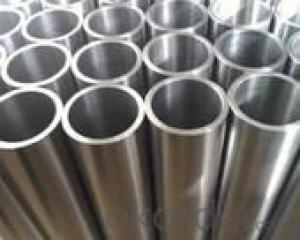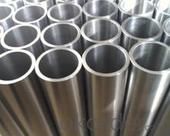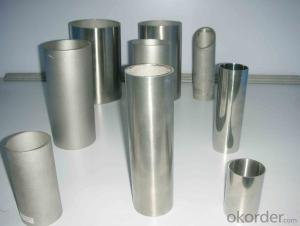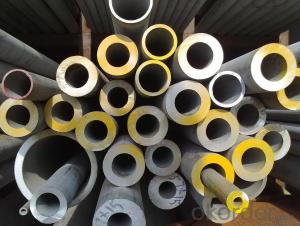The 316L stainless steel pipe
- Loading Port:
- Shanghai
- Payment Terms:
- TT OR LC
- Min Order Qty:
- -
- Supply Capability:
- 20000 kg/month
OKorder Service Pledge
OKorder Financial Service
You Might Also Like
316L is a stainless steel grades, said the main containing Cr, Ni, Mo digital percentage probably contains (not accurate, probably only), 316L is the material corresponding US label, Sus 316L is corresponding to the Japanese label. Standard of our country as 022Cr17Ni12Mo2. (new standard) of old brand 00Cr17Ni14Mo2
316L - C: chemical composition of carbon less than 0.030 silicon Si: less than or equal to 1
Manganese: less than 2 Mn
316L S: less than 0.030 sulfur
P: less than 0.035 P
Chrome Cr:16.00 ~ 18
Ni Ni:12.00 ~ 16
Mo Mo:2.00 ~ 3
Corrosion resistance
316L because of its excellent corrosion resistance is widely used in chemical industry, 316L is belong to 18-8 type austenitic stainless steel are derived, add the Mo element 2 ~ 3%. On the basis of 316L, and derived a lot of steel, such as adding a small amount of Ti derived after 316Ti, add a small amount of N derived after 316N, increased Ni, Mo content derived 317L.
The market of the existing 316L most is in accordance with the American Standard to production. Because of cost considerations, steel mills generally the Ni content of the products as much as possible to lower limit on. American standard regulation, Ni of 316L content for 10 ~ 14% day marks the regulation, Ni of 316L content for 12 ~ 15%. According to the minimum standard, American Standard and Japanese standard 2% of the difference in the Ni content, reflected in the price is quite huge, so customers in the purchase of 316L products still need to see, the product is according to ASTM or JIS standard.
Mo 316L content makes this kind of steel has excellent resistance to pitting corrosion, can be safely used in containing Cl - and halogen ion environment. As the main application of 316L is its chemical properties, surface inspection of steel on the requirements of 316L was slightly lower (relative to 304), higher on the surface of the customer must strengthen the surface inspection dynamics.
316L - Mechanical Properties of tensile strength B (MPa): 480
The yield strength of sigma 0.2 (MPa): 177
Elongation of 5 (%): 40
Section shrinkage (%): = 60 PSI
Hardness: = 187HB; = 90HRB; = 200HV
Hardness is less than or equal to 187HB = 90HRB = 200HV
Density: 7.98g/cm3;
Specific heat ratio (20 DEG C): 0.502J/ (g*K)
Thermal conductivity (W/ (m*K))
100 C 300 C 500 C
15.1 18.4 20.9
316L - heat treatment solution 1010 ~ 1150 DEG C fast cooling.
316L - metallographic organization characteristics for austenitic.
- Q: What is the difference between seamless and precision stainless steel pipes?
- The main difference between seamless and precision stainless steel pipes lies in their manufacturing processes. Seamless stainless steel pipes are made by piercing a solid stainless steel billet, while precision stainless steel pipes are created by cold rolling and cold drawing processes. This results in seamless pipes having a smoother internal surface and higher dimensional accuracy, making them suitable for applications requiring high-pressure and corrosive environments. On the other hand, precision stainless steel pipes are commonly used in industries where tight tolerances and precise dimensions are crucial, such as automotive and aerospace sectors.
- Q: Can stainless steel pipes be used for heat recovery systems?
- Yes, stainless steel pipes can be used for heat recovery systems. Stainless steel is a popular choice for heat recovery systems due to its excellent heat resistance and corrosion resistance properties. It can withstand high temperatures without warping or deteriorating, making it suitable for transferring heat from one medium to another. Additionally, stainless steel pipes have a long lifespan and require minimal maintenance, making them a durable and cost-effective option for heat recovery systems.
- Q: Are stainless steel pipes suitable for breweries?
- Yes, stainless steel pipes are highly suitable for breweries. They are corrosion-resistant, easy to clean, and maintain the quality of the beer by preventing contamination. Additionally, stainless steel pipes can withstand high temperatures and pressures, making them ideal for the brewing process.
- Q: How do you prevent pressure loss in stainless steel pipes?
- One way to prevent pressure loss in stainless steel pipes is to ensure proper installation and maintenance. This includes using high-quality fittings and connectors, following recommended guidelines for pipe sizing and support, and regularly inspecting and repairing any potential leaks or damages. Additionally, employing efficient flow control mechanisms such as valves and regulators can help minimize pressure loss in stainless steel pipes.
- Q: Can stainless steel pipes be used for oil refinery applications?
- Oil refinery applications can indeed use stainless steel pipes. Due to its exceptional resistance to corrosion, high durability, and strength, stainless steel is widely utilized in the oil and gas industry. Oil refineries face harsh and corrosive environments, including exposure to various chemicals, high temperatures, and pressure. Stainless steel pipes have the ability to withstand these conditions and provide long-lasting performance. Stainless steel pipes possess resistance to corrosion resulting from acidic and alkaline substances, which are commonly present in oil refinery operations. They also exhibit excellent resistance against pitting and crevice corrosion, making them ideal for handling crude oil, petroleum products, and other corrosive media. Moreover, stainless steel pipes can handle high temperatures without compromising their strength and integrity. This quality is crucial in oil refineries where heating and cooling processes are involved. Apart from corrosion resistance and high-temperature capabilities, stainless steel pipes also possess exceptional mechanical properties. They are robust, durable, and possess good weldability, making them suitable for the demanding conditions of oil refinery applications. In conclusion, stainless steel pipes are a reliable option for oil refinery applications due to their corrosion resistance, high-temperature capabilities, and mechanical properties. They ensure the safe and efficient transportation of oil and petroleum products, thereby contributing to the seamless operations of oil refineries.
- Q: Can stainless steel pipes be used for pulp and paper industry applications?
- Yes, stainless steel pipes can be used for pulp and paper industry applications. Stainless steel is a highly durable and corrosion-resistant material, which makes it suitable for various industrial applications, including those in the pulp and paper industry. The industry involves the transportation of corrosive chemicals and liquids, such as acids, bleaching agents, and solvents, which can degrade and corrode regular pipes over time. Stainless steel pipes, on the other hand, are resistant to corrosion and can withstand the harsh chemicals and high temperatures commonly found in pulp and paper plants. Additionally, stainless steel pipes are also hygienic and easy to clean, making them suitable for applications where cleanliness is essential, such as food-grade paper production. Overall, stainless steel pipes are a reliable and long-lasting choice for the pulp and paper industry.
- Q: Stainless steel pipe 301 material and 304 material what is the difference?
- 301 stainless steel shows obvious work hardening during deformation and is used in various occasions requiring higher strength. 301, compared with 304 steel material, C content is much, Cr and Ni content is little, cold processing tensile strength and hardness increased, without magnetism, but after cold processing has magnetism.
- Q: Can stainless steel pipes be insulated with polyurethane?
- Certainly! Polyurethane insulation is frequently utilized in multiple industries, such as plumbing and HVAC systems, for both thermal and acoustic insulation. Its outstanding thermal conductivity properties and minimal moisture absorption make it an excellent option for insulating stainless steel pipes. There are two methods to apply polyurethane insulation: as a foam or in pre-insulated pipe sections. By minimizing heat loss or gain, avoiding condensation, and enhancing energy efficiency, it effectively insulates the pipes. Moreover, polyurethane insulation is long-lasting, lightweight, and corrosion-resistant, making it a suitable choice for insulating stainless steel pipes in diverse applications.
- Q: What are the dimensions and sizes of stainless steel pipes?
- Different industrial and commercial applications are served by stainless steel pipes of varying dimensions and sizes. The sizing of these pipes is determined by their nominal diameter (DN) and the schedule or wall thickness. The nominal diameter represents the approximate internal diameter of the pipe and is commonly expressed in inches or millimeters. The most frequently available stainless steel pipe sizes range from 1/8 inch (3.175 mm) to 48 inches (1219 mm) in nominal diameter. However, larger sizes can be custom-made to meet specific requirements. The schedule or wall thickness of stainless steel pipes is indicated by a schedule number, which reflects the thickness of the pipe's walls. The most commonly used schedules for stainless steel pipes include Sch 5, Sch 10, Sch 40, and Sch 80. The higher the schedule number, the thicker the walls of the pipe. Apart from the dimensions and sizes, stainless steel pipes also come in various lengths, typically ranging from 20 feet (6.1 meters) to 40 feet (12.2 meters). Custom lengths can also be ordered based on specific project needs. It is important to note that these dimensions and sizes may differ based on the standards and specifications established by different countries and industries. Hence, it is crucial to consult the relevant standards or collaborate with a reliable supplier to ensure the precise dimensions and sizes of stainless steel pipes for a particular application.
- Q: How do you prevent pitting corrosion in stainless steel pipes?
- To prevent pitting corrosion in stainless steel pipes, several measures can be taken. First, choosing the right grade of stainless steel with high corrosion resistance, such as 316 or 904L, is important. Maintaining a passive oxide layer on the surface of the pipes through regular cleaning and passivation is also crucial. Additionally, avoiding exposure to chloride-containing environments and using coatings or linings to protect the pipe's surface can help prevent pitting corrosion. Regular inspection and maintenance to identify any potential corrosion sites and taking prompt corrective actions are essential in preventing pitting corrosion in stainless steel pipes.
Send your message to us
The 316L stainless steel pipe
- Loading Port:
- Shanghai
- Payment Terms:
- TT OR LC
- Min Order Qty:
- -
- Supply Capability:
- 20000 kg/month
OKorder Service Pledge
OKorder Financial Service
Similar products
Hot products
Hot Searches
Related keywords























